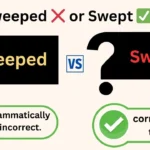Last updated on October 31st, 2024 at 08:12 am
When learning English, it’s easy to mix up words that sound similar but mean entirely different things. “Preform” and “perform” are two such words.
While they share a similar structure, each word has distinct uses, meanings, and grammatical contexts.
In this article, we’ll Jump into the unique definitions, applications, and grammar rules for these terms to help you confidently use them in any setting.
“Confused about when to use ‘preform‘ vs. ‘perform‘?
This guide breaks down the key differences, uses, and grammar tips to help you master these commonly confused terms.”
Why “Preform” and “Perform” Are Often Confused
“Preform” and “perform” can be confusing because they look and sound similar.
However, these words have entirely different roots and meanings, and using one in place of the other can result in misunderstandings.
This article will clarify:
- What each word means,
- How to use each term correctly,
- Common contexts where they’re used,
- Grammar rules to keep in mind.
Whether you’re working on formal writing, preparing for exams, or enhancing your vocabulary, understanding the differences between “preform” and “perform” will strengthen your command of the English language.
Definitions and Core Meanings
Preform: To Shape or Create in a Preliminary Form
The term “preform” is a verb meaning “to shape something into an initial or preliminary form.” It refers to preparing or shaping materials before they reach their final state.
For instance, in manufacturing, a preform might be a rough mold or an incomplete object shaped before the final product is ready.
Examples of “Preform” in a Sentence:
- The glass is preformed into a tube before it’s blown into shape.
- The preformed metal structure will later be shaped into a car door.
Perform: To Carry Out an Action or Fulfill a Role
The word “perform” is also a verb, but its meaning is quite different. “Perform” refers to the act of carrying out a task, role, or duty.
This term is often used in settings like theatre, work, and academics to indicate the completion of a task, a job, or an action.
Unlike “preform,” which is about preparation, “perform” is about execution.
Examples of “Perform” in a Sentence:
- The actor performed brilliantly in the play last night.
- Employees are expected to perform their duties responsibly.
Origins and Language Context
Understanding the origins of these terms helps clarify their meanings.
| Word | Origin | Root Meaning |
|---|---|---|
| Preform | Latin: praeformare | “To form or shape in advance” |
| Perform | Latin: performare | “To complete, accomplish, or carry out” |
- Preform comes from the Latin praeformare, meaning “to shape beforehand.” The prefix “pre-“ indicates preparation or something done in advance, which aligns with the word’s meaning of “forming beforehand.”
- Perform comes from the Latin performare, which combines “per-“ (meaning “thoroughly”) with “formare” (to shape or accomplish). This origin implies a focus on completion or execution.
Common Uses in Different Contexts
Understanding where and how “preform” and “perform” are commonly used can help you remember their differences.
Uses of “Preform”
- Manufacturing and Industrial Design: In manufacturing, “preform” refers to shaping a material before final processing. For example, metal sheets may be preformed into basic shapes before being finalized into parts.
- Science and Engineering: The word is also used in scientific and engineering contexts, often describing early stages of material formation.
- Example: Fiber optic preforms are created by arranging glass rods before they’re drawn into fibers.
Key Takeaway: “Preform” often applies to objects in a preliminary state or materials that need additional work.
Uses of “Perform”
- Entertainment and Performing Arts: In music, acting, and theater, “perform” refers to putting on a show or fulfilling an artistic role.
- Business and Work Settings: In professional contexts, “perform” means fulfilling duties or completing tasks.
- Example: Employees perform tasks to meet job expectations.
Key Takeaway: “Perform” is about action and completion, particularly of tasks, roles, or duties.
Grammar and Usage Tips
For practical application, here are some guidelines and mnemonic devices to remember when to use each word.
When to Use “Preform”
- Usage: If referring to an object, material, or substance shaped in a preliminary or early form.
- Mnemonic: Remember the prefix “pre-“ as in “prepare,” which hints at an initial stage.
Example Sentences:
- The clay is preformed into basic shapes before firing.
- They preformed a glass tube, which was later expanded into a vase.
When to Use “Perform”
- Usage: Use “perform” for actions, tasks, and roles that involve completing or fulfilling something.
- Mnemonic: Think “perform” for “present action” or “fulfillment.”
Example Sentences:
- He performed his responsibilities efficiently.
- The band performed well, drawing applause from the audience.
Common Mistakes and How to Avoid Them
It’s easy to use these words incorrectly due to their similar sounds. Here are some examples of common mistakes and how to correct them:
| Incorrect Sentence | Correct Sentence | Explanation |
|---|---|---|
| The artist preformed on stage. | The artist performed on stage. | Perform is the correct word for “carrying out” a show. |
| The glass was performed into shape. | The glass was preformed into shape. | Preform refers to shaping in the initial stages. |
Quick Tips to Avoid Mistakes:
- Tip #1: Use “preform” for objects/materials in an early or incomplete state.
- Tip #2: Use “perform” for actions, duties, and roles that require completion or execution.
Conclusion
In summary, “preform” and “perform” are two distinct words with different meanings:
- Preform: To shape or create in a preliminary state, mainly used for objects and materials.
- Perform: To complete or carry out an action, task, or role, commonly used for tasks and roles.
Understanding the nuances of each word will enhance your writing and help you avoid common errors. For anyone working in fields like manufacturing, performing arts, or engineering, mastering the difference between “preform” and “perform” is essential for clear, professional communication.
Key Takeaway: Next time you write, remember:
- Use preform for initial shaping,
- Use perform for fulfilling tasks.

Amelia Harris, a passionate educator, simplifies English grammar and vocabulary for learners of all levels. With her engaging style, mastering English has never been easie




